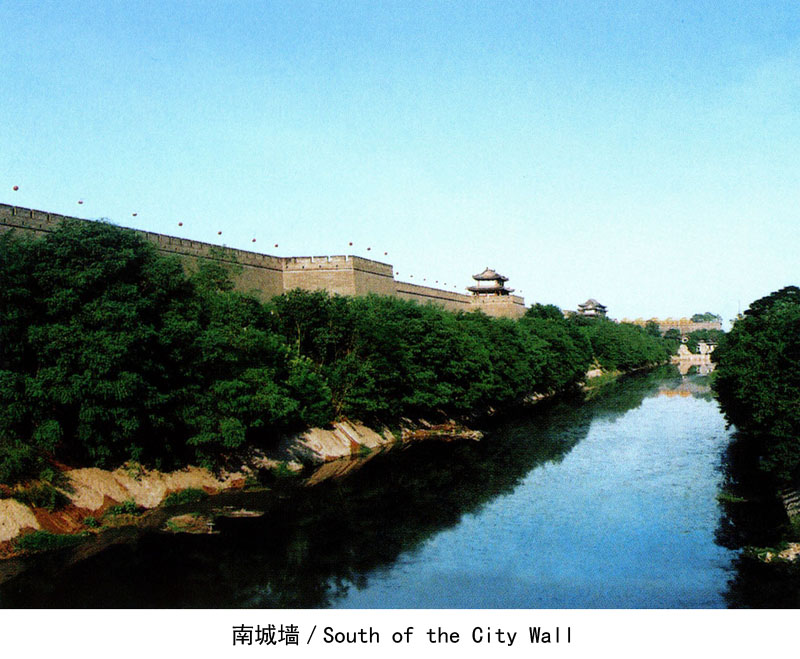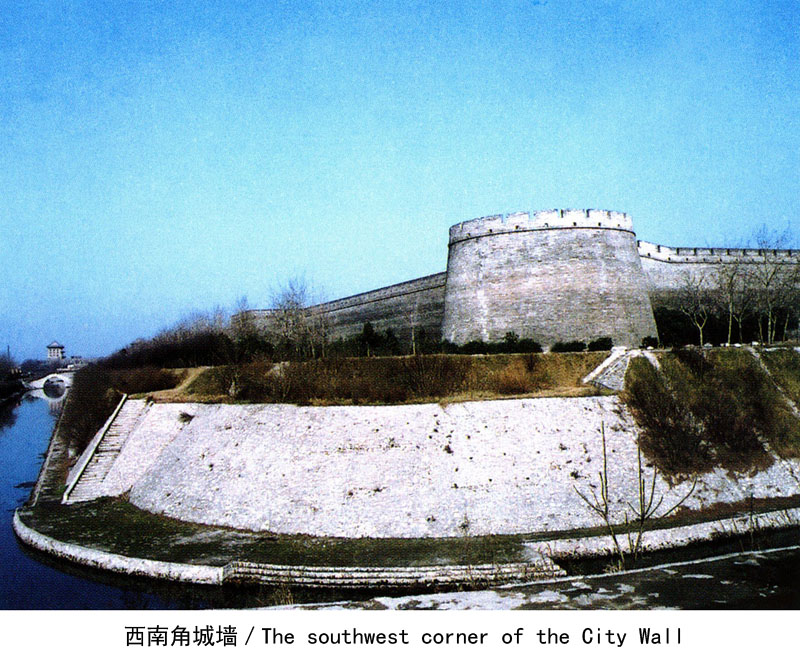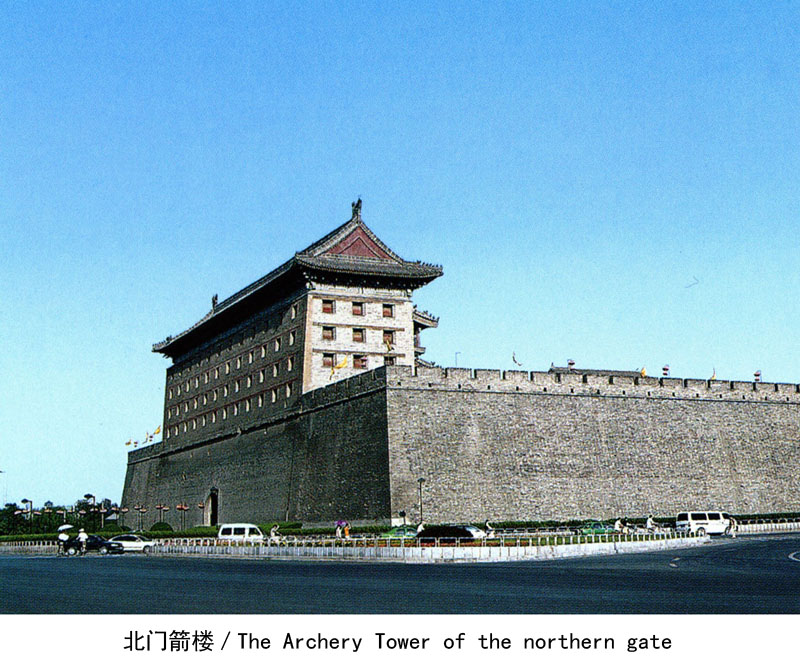丝绸之路起点——古建築篇
作者:西安市文物局




Ancient Buildings
中国传统的古代建筑基本是砖木结构。由于年代久远,历经战乱,多数已湮没无存。据文物普查统计,西安地区现存的各类古建筑不下50处。其中最早的属隋唐时期,现仅存几座砖砌的佛塔,如蜚声中外的大、小雁塔;宋元建筑很难见到;明清建筑则数量较多,最堪称道的是规整壮观的西安城墙和金碧辉煌的钟楼、鼓楼,其他主要是佛、道、伊斯兰教的宗教建筑。佛教代表建筑有慈恩寺与大雁塔、香积寺与善导塔、草堂寺与鸠摩罗什舍利塔、大兴善寺、水陆庵等;著名道观有楼观台、八仙庵等;著名清真寺有化觉巷清真寺、大学习巷清真寺等。
The traditional ancient Chinese architectures are basically brick and wood structure. Many of them have been destroyed due to the long time duration and various wars. According to the statistics,around 50 ancient buildings still exist in Xi'an, of which many are quite famous all over the world, like the two Wild Goose Pagodas which were built as early as in Sui and Tang Dynasties. Architectures of Song and Yuan Dynasties are rarely seen here, yet a great amount of buildings in Ming and Qin Dynasties are well preserved. The grand City Wall and magnificent Bell Tower and Drum Tower are typical and the most famous of these. Apart from that, many religious buildings for the Buddhism,Taoism and Islam also attract the world people's attention. The representative buildings of Buddhism include Ci'en temple, Xiang Ji Temple, Shan Dao Tower, Cao Tang Temple, Kumarajiva Pagoda, the Big Xing Shan Temple and Shui Lu Nunnery, etc. The Lou Gantai and the Eight Diagrams Temple are representatives of the Taoism buildings. The Hua Jue lane Mosque and the Big Study Lane mosque are well known mosques of Islam.
西安城墙 City Wall of Xi'an
西安城墙是明代在唐皇城城墙基础上扩建而成的,建于明洪武七年至十一年(1374—1378),墙体全长13.7公里,墙高12米,垛口5984个,城门4座,各门外均建有护门瓮城,瓮城上建有城楼、箭楼各1座,瓮城外临护城河,建有“吊桥”及“闸楼”等。城墙自建成后历经三次大的整修,特别是1983年以来,陕西省和西安市人民政府对这座古城墙进行了大规模修缮,建成环城公园,连接贯通整个城墙,使这座古建筑焕发了昔日风采,成为西安的一大旅游景观。西安城墙在明、清时是一个庞大、坚固、严密的城防体系,是中国大型城垣中保存最为完整的建筑。现为全国重点文物保护单位。
The City Wall in Xi'an was built from Hong Wu the 7th to the 11th in Ming Dynasty (1374-1378). It was extended and rebuilt on the basis of royal city of Tang Dynasty. The City Wall extends 13.7 kilometers,with a height of 12 meters. On the outer side of the city wall, there are 5948 parapets, namely battlements. In Xi'an, the city wall includes four gates and each has a urn-shaped city outside. Each city gate has Archery Tower. Outside the city wall is the city moat, there is a suspense bridge on it. The City Wall has been restored three times since it was built. Since 1983, particularly, the governments of Shaanxi and Xian have held a great scale remedy. The establishment of Round city Park has connected the City Wall and sight makes it new scenery of Xi'an. City wall of Xi'an served as a protection system in Ming and Qing Dynasties and is the best preserved and most intact architectures city walls in China. Now it is the key National Cultural Relics' preservation institution.
钟楼 Bell Tower
钟楼位于西安城中东、南、西、北四条大街交汇处。昔日楼上悬一口大钟,每日击钟报时,故名钟楼。始建于明洪武十七年(1384),是一座重檐三滴水四角攒尖顶的楼阁式木结构建筑,通高36米,面积1377.64平方米,用青砖白灰砌筑而成,为古城西安的标志性建筑。现为全国重点文物保护单位。
The Bell Tower locates in the cross of Xi'an's four streets: the east, west, north and south streets. In former days there is a big bell hung on upstairs, the bell strike to tell the time everyday, thus comes the name Bell Tower. The tower was built in 1384 by Emperor Zhu Yuanzhang. It has three layers of eaves but only two stories. Inside, a staircase spirals up. Itstands on a brick base of 1,377.64 meters of coverage and 36 meters (28.2 feet) high on each side. The Bell Tower as a symbol of Xi'an city, The Bell Tower is the key National Cultural Relics' Preservation Institution.
鼓楼 Drum Tower
鼓楼位于西安古城内西大街北院门南段,建于明洪武十三年(1380),楼上原有巨鼓一面,每日击鼓报时,故称鼓楼。鼓楼与钟楼同属重檐三滴水的楼阁式建筑,两楼互称为“姊妹楼”或“文武楼”。鼓楼通高34米,原“文武盛地”、“声闻于天”金字蓝底巨型木匾经复原后现分悬南北。现为全国重点文物保护单位。
The Drum Tower is located at south segment of Bei yuan Gate in the West Street of Xi'an city. It was built in 1380, the 13th year of Hong Wu in Ming Dynasty(1380AD).There used to be a huge drum upstairs. Everyday the drum was striken to the tell the time, so we call it ‘the drum Tower’. The drum Tower and the Bell Tower belong to the same type of buildings, so they are also called ‘the sibling buildings’. The Drum Tower has a height of 34 meters, with two blue wood plaques hanging on its north and south sides. Each of the two plaques has gold-plated letters on it: one writes ‘The place for civil and military uses’ and the other writes ‘The sound of the drum can reach as high as to the heaven.’ The Drum Tower is the key National Cultural Relics' Preservation Institution.
大慈恩寺与大雁塔 Ci'en Temple and Big wild Goose Pagoda
大慈恩寺位于西安市雁塔区雁塔路南端,建于唐贞观二十二年(648)。寺内大雁塔是为了保存玄奘从印度带回的佛经、佛像建造的,塔为7层,高64.52米,呈方形角锥状,这种楼阁形砖塔造型是中国佛教建筑的杰作。现为全国重点文物保护单位。
The Ci'en Temple locates in the south of Yan TaRoad of Yan Ta District. It was set up in the 22nd year of Zhen Guan in Tang Dynasty(648 AD). The Big Wild Goose pagoda inside the temple was built for the purpose of preserving the Buddhist scriptures and the statues which were brought back from India by Xuan Zang, a famous monk in Tang Dynasty. The tower has 7 layers, with a height of 64.52 meters. Shaping like a square awl, the brick tower presents typical architectures of Chinese Buddhist buildings. Now it is the key National Cultural Relics' Preservation Institution.
荐福寺与小雁塔 Jian Fu Temple and Small Wild Goose Pagoda
荐福寺位于西安市友谊西路东段南侧,建于唐睿宗文明元年(684)。寺内小雁塔为密檐式中空砖构建筑,现为13层,高43.3米。明成化二十三年(1487),关中地震,塔身中部纵裂,出现近40厘米的缝隙,至1521年又一次地震时,塔复完好如初。现为全国重点文物保护单位。
The Jian Fu Temple locates in the east segment of You Yi Road, and was set up in the first year of Wen Ming in Tang Dynasty(684 AD). The small Wild Goose Pagoda inside the temple was build of the hollow brick structure. It has 13 floors with a height of 43.3 meters. In the 23rd of Cheng Hua of Ming Dynasty (1487), an earthquake occurred in the central area of Shaanxi Province. The center of the pagoda cracked, and a 40cm long gap appeared. Surprisingly, when another earthquake strike Shaanxi in 1521, the pagoda healed itself as if nothing has happened. Now it is the Key National Cultural Relics' protection institution.
香积寺与善导塔 Xiang Ji Temple and Shan Dao Pagoda
香积寺位于西安市长安区,建于唐中宗神龙二年(706)。寺内善导塔是密檐式砖塔,塔身呈四角锥体,原为13级,残存11级,现高33米,平面呈方形,塔身用青砖砌成。现为全国重点文物保护单位。
Xiangji Temple is situated in Chang'an County. It was set up in the 2nd year of Shen Long in Tang Dynasty(706 AD). The Shan Dao Pagoda inside the temple is a brick structure tower, Shaping like a pyramid body, it has 13 floors at first. Now only 11 floors are left. The square pagoda is 33 meters high and the body was built by the green brick. Now it is the key national cultural relics' preservation institution.
八仙庵 Eight Fairies Temple
八仙庵位于西安市东关长乐坊,道教全真派道观。传说始建于宋代,现存建筑多为清代所建。因庵内有传说中的“八仙”塑像,故名。主要大殿有吕祖殿、斗姥殿、五祖殿、八仙殿,后侧有药王殿,内供奉唐代名医孙思邈。现为陕西省文物保护单位。
Eight Diagrams Temple is located in Chang Lefang of the east Xi'an City ,the temple for Quan Zhen religion of Taoism. It is said that the temple was built in Song Dynasty although the present construction was rebuilt in Ming Dynasty. The name of the temple comes from the eight fairies in the legend. The main buildings are: Lv Zu Palace, the Dou Mu palace, the Five Ancestor Palace, the Eight Fairies Palace and the Medicine Master Palace with the famous doctor Sun Simiao inside. Now it is the provicial cultural relics' preservation institution.
草堂寺与鸠摩罗什舍利塔 cao Tang Temple and Kumarajiva Pagoda
草堂寺位于西安市户县。初建年代待考。寺内“鸠摩罗什舍利塔”为八面十二层亭阁式石塔,通高2.3米,整个石塔用大理石雕琢而成。每层石色不同,有砖青、玉白、乳黄等色,故又称“八宝玉石塔”。据造型及纹饰推断,当为唐代遗物。现为全国重点文物保护单位。
The Cao Tang Temple locates in the Hu Xian County of Xi'an. The year of building it is still not clear. The Kumarajiva Pagoda inside is a stone tower with 12 floors extending to 8 directions. Engraved in marble, it has a height of 2.3 meters. Each floor has a different stone colors, like the brick green, jade white, milk yellow etc. So this is also called ‘The eight colors jade tower’. According to the shape and the lines, it should be built in Tang Dynasty. It is the key national cultural relics' preservation institution.
兴教寺与玄奘塔 Xing Jiao Temple and Xuan Zang Pagoda
兴教寺位于西安市长安区。建于唐高宗总章二年(公元669年)。现存玄奘、窥基、圆测三塔,呈“品”字形排列,中间最高的一座是玄奘墓塔,此塔平面呈正方形,塔身5层,砖砌楼阁式,二层以上塔身实砌,宝瓶葫芦顶,底边长5.2米,通高23米。玄奘塔左右各有较矮小的三层砖塔一座,均高7米,底边长2米,分别为玄奘弟子窥基(西)和新罗王之孙圆测(东)的灵塔,造于公元682年和公元1115年,形式与玄奘塔略同。现为全国重点文物保护单位。
The Xing Jiao temple is located in Chang'an County of Xi'an. It was built in the second year of Zong Zhang in Tang Dynasty(669AD). Three towers remained in this temple: Xuan Zang Tower, Kui Ji Tower and Yuan Ce Tower. These three form like the Chinese character ‘Pin’. Of all the three, the tallest in the center is the Xuan Zang Tower which presents the exact square from the surface. Having 5 layers for body, the brick-made building looks like a gourd at its top. The tower is 5.2 meters long in hemline and 23 meters high from the bottom to the top. Beside the Xuan Zang Tower there are two three-floor brick towers separately. Both have a height of 7meters and a hemline of 2 meters long. These west one was built in honor of Xuan Zang's student, Kui Ji and the east one for Yuan Ce, who was the grandson of King of Xin Luo. These were built in 682 AD and 1,115 AD respectively and have a similar shape to Xuan Zang Tower. Now it is the key national cultural relics' preservation institution.
城隍庙 Cheng Huang Temple
西安城隍庙位于西安市西大街大学习巷东侧,建于明宣德八年(1433),分为庙院与道院两部分。庙院在正中,道院分布两侧,建筑有二门、戏楼、二道牌坊、大殿和东西厢房,其中以清雍正元年(1723)建造的大殿最为壮观。现为全国重点文物保护单位。
The Cheng Huang Temple of Xi'an is located in the east of Da Xuexi Lane of the west avenue of Xi'an City. It was set up in the eighth year of Xuan De of Ming Dynasty(1433),It is divided into two parts: the temple yard and a Taoist yard. The Temple yard lies in the middle with Taoist yard on each side. Besides, it has two gates, an opera floor, two toriis, a main hall and east and west wing-room. The main hall built in 1723 is the grandest of them all. Now it is the key national cultural relics' preservation institution.
水陆庵 Shui Lu Nunnery Temple
水陆庵位于西安市蓝田县。原为建于六朝时的悟真寺北普陀兰渚庵内的水陆殿,在唐代时是全国著名寺院。庵的建筑均坐西面东,中轴线上有中殿3间,大雄宝殿5间,建筑基本为明代风格。大雄宝殿内的佛像和壁塑最值得称道。现为全国重点文物保护单位。
The Shui Lu Nunnery Temple locates in Lan Tian County of Xi'an City. It first belonged to the North Pu Tuolanzhu Nunnery of Wu Zhen Temple in Liu Dynasty, and was one of the most famous temples in Tang Dynasty. The building of the nunnery all face to east. There are 3 medium palaces in the central axes and 5 grand palaces with traditional Ming style. The most noticeable ones in the grand place are the statues of Buddha and the sculptures on the wall. Now it is the key national cultural relics' preservation institution.
西安清真大寺 Great Mosque in Xi'an
西安清真大寺位于鼓楼西北的化觉巷内,是西安地区现存规模最大、保存最完整的明代建筑群,又名化觉巷清真大寺。寺院座西向东,东西长250米,南北宽50米,周砌砖墙。寺内沿东西向中轴线分四进院落,有殿、亭、楼、台、厅、堂180余间,置墙相隔,设门楼门厅前后贯通,这些建筑多为明或清初所建。院中有高9米的木结构大牌楼,上额刻“敕赐礼拜寺”,颇为壮观。殿内天棚藻井600余幅,书以阿拉伯文图案,构图着色,各有千秋。后殿壁上有板雕蔓草花纹,内套阿拉伯文,为雕刻彩画之珍品。寺院前后有多处雕砖花墙,刻画精美,气象生动。现为全国重点文物保护单位。
The Great Mosque in Xi'an is one of the oldest, largest and best-preserved Islamic mosques in China and its location is northwest to the Drum Tower (Gu Lou) on Huajue Lane. This was built in Ming Dynasty. The brick made mosque is facing to east, with a length of 250 meters and a width of 50 meters. From the east and west to the center axes, the mosque can be divided into four parts, with over 180palaces, booths, floors, platforms and halls. All these were separated by the brick walls with a gateway connecting the front and the back. Most of these buildings were built in the early Ming and Qing Dynasties. Inside the mosque there is a 9-meter high wood-made pailou, with sculptures of ‘Admonishing Worship Temple’, which makes the pailou magnificent. Also, more than 600 paintings on Tian Pengzaojing with Arabic illustrations and several other precious paintings present a vivid view of the mosque. Now it is the key national cultural relics' preservation institution.
公输堂 Gong Shu Hall
公输堂位于西安市户县县城北,明永乐年间“向阳三会”教众在此建堂传教。现存后殿三间,俗称“万佛堂”。其建筑以箱体结构为搭接穿逗方式,油漆采用“紫笼罩”工艺,彩绘用“卧金点翠”法,将仙草花卉、山水人物、龙凤博古等溶为一起,反映了佛、道、儒三教故事,被誉为中国现存小木作建筑中品味最高、工艺最精、雕刻最细、结构最绝的建筑。现为全国重点文物保护单位。
Gong Shu Hall lies in the north of Hu Xian county of Xi'an City, ‘the Xiang Yang Three Churches’of Yong Le in Ming Dynasty spread their doctrines here. Now it has three back palaces with the so called name ‘Thousands of Buddha hall’.It was built with the structure of connecting each other and painted with a special skill. The colorful paintings of grass, flowers, landscapes and characters reflected the legends of Badahism, Confusian and Taoism. It boasts to be the architecture with finest craftworks and carvings. Now it is the key national cultural relics' preservation institution.
西安事变旧址 Site of Xi'an Incident
西安事变旧址包括张学良公馆、西安事变指挥部、新城黄楼、止园、高桂滋公馆、西京招待所、华清池五间厅、兵谏亭等8处。张公馆为东西排列的三座三层砖木结构西式楼房,面积约7700平方米。西安事变指挥部位于西安新城陕西省人民政府内的杨虎城公馆,砖木结构,面积389平方米。止园在北大街青年路,占地3.9万平方米,主楼为中西合璧砖木结构的三层小楼,占地424.12平方米。华清池五间厅背靠骊山,西安事变发生当天蒋介石由此逃至骊山一巨石缝隙中,后来在巨石附近建亭,先后以“正气亭”、“避难亭”、“捉蒋亭”、“兵谏亭”为名。现为全国重点文物保护单位。
The former site of Xi'an Incident includes Zhang Xueliang's private home, the headquarters of Xi'an Incident, the yellow building in Xin Cheng district, Zhi Yuan Garden, Gao Guizi private home, Xi Jing Resthouse, Five Space Halls in Hua Qing Palace, and a booth. Zhang Xueliang's private home are three brick and wood-made western style houses with three floors and totals 7,700 square meters of coverage. The headquarter of Xi'an Incident lies in Yang Hucheng's private home in the Xin Cheng district of Shaanxi people's government of Xi'an. With the brick and wood structure, it covers an area of 389 square meters. Zhi Yuan Garden is located in the Youth Road of North Avenue with an area of 39,000 square meters. The main building is a three-floor brick wood structure with both western and traditional Chinese style. This covers 424.12 square meters. The Five Space Hall in Hua Qing Palace are against the Li Shan Mountain. When the Xi'an Incident happened, Jiang Jieshi ran and hid into a aperture of a huge rock in Li Shan Mountain. After that, people made a booth around this huge rock and take the names ‘the sense of right kiosk’, ‘seeking refuge kiosk’, ‘catching JIANG kiosk’, ‘advising kiosk’. Now it is the key national cultural relics' preservation institution.
八路军驻西安办事处旧址 Former Site of Eighth Route Army Xi'an Office
西安八路军办事处旧址位于西安市北新街,共有10所坐北向南的院落,均为四合院式建筑。其中1号院为主要办公地点,南北长82米、东西宽17米,占地面积1300多平方米。如今1、3、4、7号院以及周恩来等老一辈无产阶级革命家曾居住、办公的地方和外国友人居住的地方都已复原开放,还开辟了陈列室,收藏陈列当年使用过的文件、证章、电台设备、新闻图片、书刊和烈士手稿等革命文物。现为全国重点文物保护单位。
The former site of Eighth Route Army Xi'an office stands in the Bei Xin street of Xi'an City, with a total 10 Si He styled courtyards facing the south. The first courtyard is the main office building with a length of 82 meters, stretching from south to north. It is 17 meters wide from east to west and covers an area of 1,300 square meters. Nowadays the NO. 1,3,4,7 courtyards where Premier Zhou Enlai and other former leaders and foreign friends lived or worked have been restored and open to the public. Apart from that, it has a showroom displaying the cultural relics' such as files, badges, radio station facilities, news picture, books and periodicals and the martyr manuscript etc. Now it is the key national cultural relics' preservation institution.
华夏文明故都 丝绸之路起点/西安市文物局编著.-西安: 世界图书出版西安公司, 2005;陕西